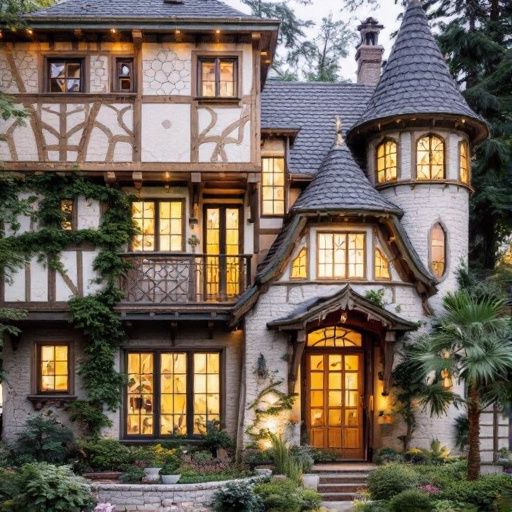Featured Articles
- "Decoding the Mystery: How Folklore Influences Modern Home Designs in Unexpected Ways"
- Reimagining Ruins: How Abandoned Spaces Are Inspiring Modern Home Designs and Eco-Conscious Living
- Reimagining Spaces: How Biophilic Design Can Transform Mental Health in Your Home
- Reviving the Past: How Retro Futurism is Reshaping Modern Home Design with a Twist of Nostalgia
- Revolutionizing Spaces: How Biophilic Design is Transforming Urban Home Environments into Nature-Infused Sanctuaries
Top 8 Cutting-Edge Home Innovations Launched Since 2019: Expert Reviews and Rankings for Modern Living
Top 8 Cutting-Edge Home Innovations Launched Since 2019: Expert Reviews and Rankings for Modern Living
Top 8 Cutting-Edge Home Innovations Launched Since 2019: Expert Reviews and Rankings for Modern Living
1. Smart Thermostats with AI Integration
Since 2019, smart thermostats have leaped forward with AI-powered learning capabilities that adjust home temperatures based on occupants' behaviors. Leading models like the Google Nest Learning Thermostat have enhanced their algorithms, reducing energy consumption significantly.
Experts rate these devices highly for seamless user interfaces and energy savings, with independent studies reporting up to 15% reduction in heating and cooling bills. Their integration with voice assistants and smart home ecosystems adds convenience and automation to climate control.
However, some reviewers caution about privacy concerns, as these devices collect detailed usage data. Nonetheless, for modern living, AI-driven thermostats represent a smart investment combining comfort, savings, and sustainability.
2. Advanced Robot Vacuum Cleaners
Robotic vacuum cleaners have transformed with improved navigation and mapping technologies, now equipped to handle multi-floor homes and complex layouts. Brands like iRobot Roomba S9+ and Roborock S7 offer superior suction and obstacle avoidance.
Experts commend these innovations for their time-saving convenience and effectiveness, especially models featuring automatic dirt disposal and mopping functions. Reviews emphasize their quiet operation and app-based controls that allow scheduling and remote monitoring.
Despite higher costs, these robot vacuums are valued for reducing manual chores, particularly in modern busy households. Continuous firmware upgrades ensure their capabilities expand over time, keeping them at the forefront of home cleaning technology.
3. Voice-Activated Smart Kitchens
The smart kitchen has advanced with voice-activated appliances such as ovens, refrigerators, and coffee makers, enhancing ease of use and connectivity. Samsung and LG have launched models featuring AI recipe suggestions and inventory tracking.
Experts highlight the integration of these devices into smart home platforms like Amazon Alexa and Google Assistant, facilitating multitasking while cooking. The features enable hands-free operation and energy efficiency.
However, professional chefs sometimes find such devices limited for more complex culinary needs. Still, for everyday users, voice-activated kitchens streamline meal preparation and optimize appliance performance.
4. Energy-Efficient Smart Windows
Since 2019, smart window technologies using electrochromic glass have gained traction, allowing users to control tint levels to regulate light and heat entering homes. Companies like View have developed windows that respond to environmental conditions automatically.
Academic reviews stress their potential for reducing HVAC loads and enhancing occupant comfort. The dynamic tinting capability offers privacy without sacrificing natural light.
Price and installation complexity remain barriers for widespread adoption, yet these windows stand as a promising innovation for sustainability-aware homeowners looking to modernize their living spaces.
5. Integrated Home Security Systems
Home security systems have evolved into fully integrated platforms combining cameras, motion detectors, and smart locks, all controllable via smartphone apps. Companies like Ring and Arlo have introduced features such as real-time alerts and cloud storage enhancements.
Experts value these systems for their ease of installation and scalability, suitable for a range of home sizes and budgets. Reviews frequently note the usefulness of AI-powered facial recognition and package detection in reducing false alarms.
Privacy advocates urge careful consideration of data policies, but overall, integrated security solutions provide peace of mind through advanced monitoring tailored for modern homes.
6. Smart Lighting Systems with Circadian Rhythm Features
Smart lighting technology has progressed beyond remote control to influence users’ well-being through circadian rhythm-aligned color temperature adjustments. Philips Hue and LIFX offer bulbs that automatically transition lighting tones to match natural daylight cycles.
Health experts suggest these systems can improve sleep quality and productivity by syncing indoor lighting with biological rhythms. User feedback highlights customization options and seamless integration with other smart devices.
While initial costs can be steep, the benefits for mental and physical health make smart circadian lighting a worthwhile consideration for modern living environments.
7. Water-Efficient Smart Faucets
Smart faucets introduced recently focus on reducing water usage through touchless activation and flow control technologies. Brands like Kohler and Moen have launched models featuring motion sensors and voice commands to prevent wastage.
Environmental organizations endorse these innovations for contributing to sustainable water consumption in households. Experts highlight benefits such as hygiene improvement and water bill savings.
Despite some concerns over sensor sensitivity and installation compatibility, smart faucets represent a practical solution aligning modern convenience with environmental responsibility.
8. Modular Smart Furniture
Innovations in modular furniture incorporate technology such as wireless charging, embedded speakers, and adjustable ergonomics. Companies like Ori and Sobro have designed pieces that optimize space and functionality, particularly for urban living.
Design critics appreciate the marriage of aesthetics and tech, noting that these furnishings adapt fluidly to changing user needs. Reviews commend their build quality and ease of integration into smart home systems.
While premium-priced, modular smart furniture offers versatility and modern convenience, catering to homeowners seeking transformation without major renovations.
9. Home Energy Storage Solutions
The rise of residential energy storage, such as Tesla Powerwall and LG Chem RESU, enables greater self-consumption of solar energy and backup power independence. Since 2019, these systems have become more compact and efficient.
Energy analysts praise their role in reducing reliance on the grid and lowering carbon footprints. User testimonials report significant savings and resilience during outages.
Although substantial upfront investments and technical requirements exist, home energy storage is a key innovation for sustainability-conscious homeowners aiming to future-proof their residences.
10. Augmented Reality for Home Design
Augmented reality (AR) applications for interior design have flourished, enabling users to visualize furniture, paint colors, and layouts before purchasing. Programs like IKEA Place and Houzz AR provide immersive planning experiences.
Industry experts highlight AR’s influence on reducing design errors and enhancing customer satisfaction. The technology democratizes design, making professional-level planning accessible to everyone.
With improving device compatibility and interface simplicity, AR tools are becoming indispensable for modern homeowners undertaking renovations or decorating projects.
Sources:
- U.S. Department of Energy, "Smart Thermostats and Energy Savings," 2021
- Consumer Reports, "Best Robot Vacuums 2023," 2023
- Journal of Sustainable Building Technology, "Smart Windows and Energy Efficiency," 2022
- National Sleep Foundation, "Lighting and Circadian Health," 2020
- Environmental Protection Agency, "WaterSense Smart Faucet Technologies," 2021
- Tesla, "Powerwall Product Specifications," 2023
- Ikea and Houzz Official Websites, AR Application Launches, 2019-2023




